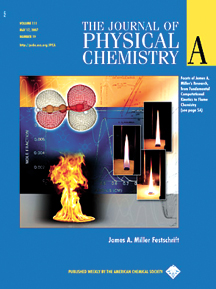
The Journal of Physical Chemistry has recently published (Vol. 111, Issue 19, May 17, 2007) a Festschrift issue to honor the career of Sandian Jim Miller (8353). The entire issue is a collection of articles submitted by combustion chemists to honor Jim’s long and productive career.
“This is really thrilling,” says Jim of his tribute issue. He describes it as a highlight of his career, along with winning the Bernard Lewis Gold Medal from the Combustion Institute last year.
A Festschrift is a book honoring a respected academic, usually in honor of an anniversary, retirement, or notable achievement. The term comes from the German word for celebration publication. This Journal of Physical Chemistry Festschrift is in honor of Jim’s 60th birthday.
“Jim is an intellectual leader and a guiding force for Sandia’s energy science program and the Combustion Research Facility,” says Terry Michalske, director of Biological and Energy Sciences Center 8300. “His Festschrift is a fitting recognition of his contributions to the international scientific community.”
Difficult to overestimate Jim’s impact
The introduction to this issue begins by stating that “Jim Miller is one of the most influential combustion modelers in the world; it is difficult to overestimate the impact that Jim Miller’s work has had on the combustion community. But because of the rigor and detail of his chemistry contributions, his remarkable influence spreads beyond the sphere of combustion to the heart of fundamental gas-phase chemical reaction theory.”
The cover (see image at right) includes a montage of images representing the impact of Jim’s work on physical chemistry and combustion. A representation of the propargyl radical, whose reactions are key to soot formation in hydrocarbon flames, and images of sooting flames are superimposed on figures taken from several of Jim’s publications.
The issue also includes an essay by Jim, titled “My Life and Career (So Far) in Combustion Chemistry.” In the essay he describes his early life, noting that he was one of the first baby boomers — born nine months after his father returned home from World War II.
Jim’s father and grandfather worked as coal miners. As a child he was not particularly drawn to science and was the first on either side of his family to attend college. He earned a BS in engineering from the University of Cincinnati and a MEng and PhD from Cornell.
Jim began working at Sandia in the spring of 1974 and helped open the Combustion Research Facility in 1980. Among the many achievements in his career, the development of CHEMKIN™ is especially notable. It is the de facto standard software for modeling chemical kinetics in combustion.
Currently Jim is working with Stephen Klippenstein of Argonne National Laboratory and a former Sandian to develop and implement a theoretical apparatus for studying chemical reactions involving multiple, interconnected potential wells. Such reactions are of paramount importance in the formation of aromatic compounds, polycyclic aromatic compounds (PAH), and soot in flames of aliphatic (non-cyclic) fuels.
To learn more about Jim’s long and influential career, visit the The Journal of Physical Chemistry website.